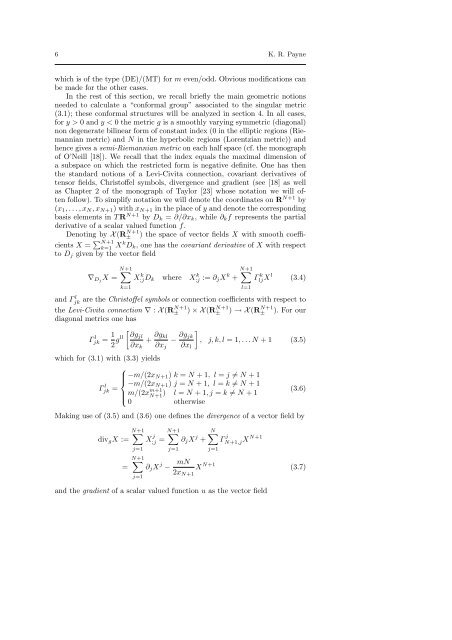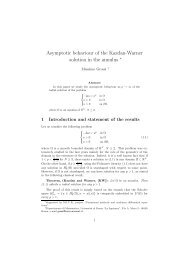Singular metrics and associated conformal groups underlying ...
Singular metrics and associated conformal groups underlying ...
Singular metrics and associated conformal groups underlying ...
You also want an ePaper? Increase the reach of your titles
YUMPU automatically turns print PDFs into web optimized ePapers that Google loves.
6 K. R. Payne<br />
which is of the type (DE)/(MT) for m even/odd. Obvious modifications can<br />
be made for the other cases.<br />
In the rest of this section, we recall briefly the main geometric notions<br />
needed to calculate a “<strong>conformal</strong> group” <strong>associated</strong> to the singular metric<br />
(3.1); these <strong>conformal</strong> structures will be analyzed in section 4. In all cases,<br />
for y > 0 <strong>and</strong> y < 0 the metric g is a smoothly varying symmetric (diagonal)<br />
non degenerate bilinear form of constant index (0 in the elliptic regions (Riemannian<br />
metric) <strong>and</strong> N in the hyperbolic regions (Lorentzian metric)) <strong>and</strong><br />
hence gives a semi-Riemannian metric on each half space (cf. the monograph<br />
of O’Neill [18]). We recall that the index equals the maximal dimension of<br />
a subspace on which the restricted form is negative definite. One has then<br />
the st<strong>and</strong>ard notions of a Levi-Civita connection, covariant derivatives of<br />
tensor fields, Christoffel symbols, divergence <strong>and</strong> gradient (see [18] as well<br />
as Chapter 2 of the monograph of Taylor [23] whose notation we will often<br />
follow). To simplify notation we will denote the coordinates on RN+1 by<br />
(x1, . . . , xN, xN+1) with xN+1 in the place of y <strong>and</strong> denote the corresponding<br />
basis elements in T RN+1 by Dk = ∂/∂xk, while ∂kf represents the partial<br />
derivative of a scalar valued function f.<br />
Denoting by X (R N+1<br />
± ) the space of vector fields X with smooth coefficients<br />
X = N+1 k=1 XkDk, one has the covariant derivative of X with respect<br />
to Dj given by the vector field<br />
∇Dj X =<br />
N+1 <br />
k=1<br />
<br />
X k ;jDk where X k ;j := ∂jX k N+1<br />
+<br />
l=1<br />
Γ k<br />
ljX l<br />
(3.4)<br />
<strong>and</strong> Γ l jk are the Christoffel symbols or connection coefficients with respect to<br />
the Levi-Civita connection ∇ : X (R N+1<br />
± ) × X (R N+1<br />
± ) → X (R N+1<br />
± ). For our<br />
diagonal <strong>metrics</strong> one has<br />
Γ l jk = 1<br />
2 gll<br />
<br />
∂gjl<br />
+<br />
∂xk<br />
∂gkl<br />
−<br />
∂xj<br />
∂gjk<br />
<br />
, j, k, l = 1, . . . N + 1 (3.5)<br />
∂xl<br />
which for (3.1) with (3.3) yields<br />
Γ l ⎧<br />
⎪⎨<br />
−m/(2xN+1) k = N + 1, l = j = N + 1<br />
−m/(2xN+1) j = N + 1, l = k = N + 1<br />
jk =<br />
⎪⎩<br />
m/(2x m+1<br />
N+1 ) l = N + 1, j = k = N + 1<br />
0 otherwise<br />
(3.6)<br />
Making use of (3.5) <strong>and</strong> (3.6) one defines the divergence of a vector field by<br />
divgX :=<br />
=<br />
N+1 <br />
j=1<br />
N+1 <br />
j=1<br />
X j<br />
;j =<br />
N+1<br />
<br />
∂jX j N<br />
+<br />
j=1<br />
j=1<br />
∂jX j − mN<br />
X<br />
2xN+1<br />
N+1<br />
Γ j<br />
N+1,j XN+1<br />
<strong>and</strong> the gradient of a scalar valued function u as the vector field<br />
(3.7)








